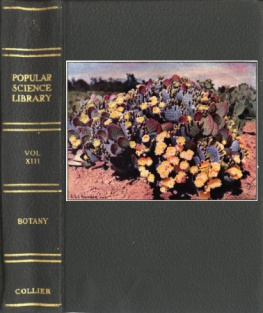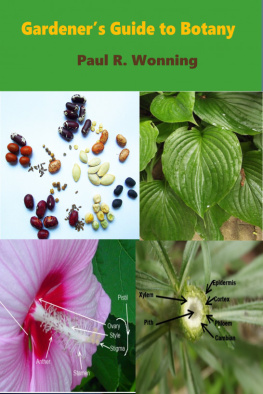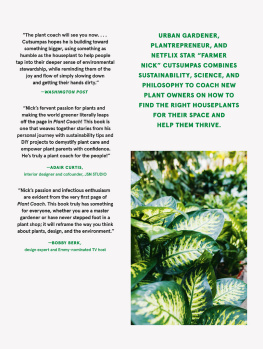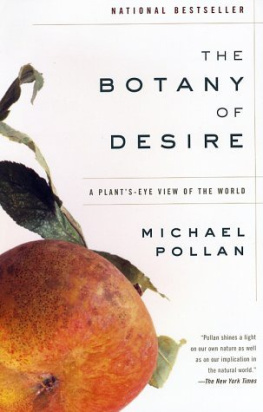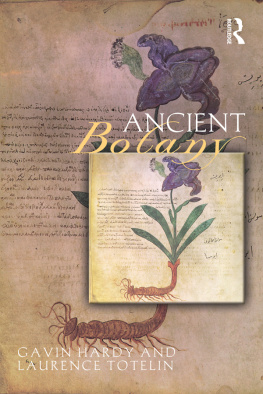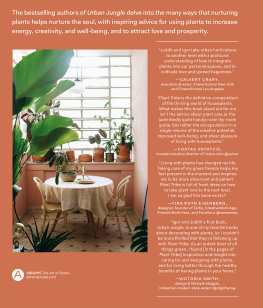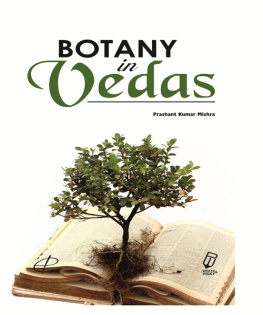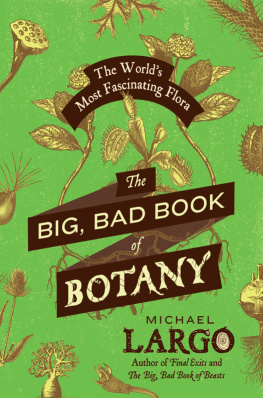Norman Taylor - Botany
Here you can read online Norman Taylor - Botany full text of the book (entire story) in english for free. Download pdf and epub, get meaning, cover and reviews about this ebook. year: 2015, genre: Science. Description of the work, (preface) as well as reviews are available. Best literature library LitArk.com created for fans of good reading and offers a wide selection of genres:
Romance novel
Science fiction
Adventure
Detective
Science
History
Home and family
Prose
Art
Politics
Computer
Non-fiction
Religion
Business
Children
Humor
Choose a favorite category and find really read worthwhile books. Enjoy immersion in the world of imagination, feel the emotions of the characters or learn something new for yourself, make an fascinating discovery.
- Book:Botany
- Author:
- Genre:
- Year:2015
- Rating:5 / 5
- Favourites:Add to favourites
- Your mark:
- 100
- 1
- 2
- 3
- 4
- 5
Botany: summary, description and annotation
We offer to read an annotation, description, summary or preface (depends on what the author of the book "Botany" wrote himself). If you haven't found the necessary information about the book — write in the comments, we will try to find it.
Perhaps few of us realize that without plants all our modern civilization would be swept away. This book is for those who want some general knowledge of the plant world, without necessarily caring for the technical details upon which such knowledge is based.
Botany — read online for free the complete book (whole text) full work
Below is the text of the book, divided by pages. System saving the place of the last page read, allows you to conveniently read the book "Botany" online for free, without having to search again every time where you left off. Put a bookmark, and you can go to the page where you finished reading at any time.
Font size:
Interval:
Bookmark:
The Project Gutenberg EBook of Botany, by Norman Taylor
This eBook is for the use of anyone anywhere at no cost and with
almost no restrictions whatsoever. You may copy it, give it away or
re-use it under the terms of the Project Gutenberg License included
with this eBook or online at www.gutenberg.org/license
Title: Botany
The Science of Plant Life
Author: Norman Taylor
Release Date: June 14, 2015 [EBook #49211]
Language: English
*** START OF THIS PROJECT GUTENBERG EBOOK BOTANY ***
Produced by Juliet Sutherland, Chuck Greif and the Online
Distributed Proofreading Team at http://www.pgdp.net
(In certain versions of this etext, in certain browsers, clicking on this symbol (etext transcriber's note) |

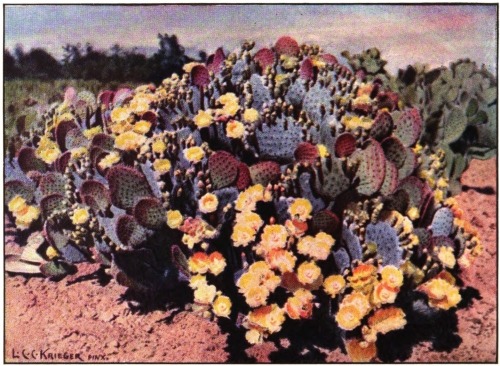
The prickly pear (Opuntia chlorotica santarita) of the desert in the American Southwest.
(This painting was kindly loaned by Dr. David Griffiths of the United States Department of Agriculture and reprinted here through the courtesy of the Journal of the International Garden Club, where it first appeared.)
Courtesy Journal of the International Garden Club
Popular Science Library
EDITOR-IN-CHIEF
GARRETT P. SERVISS
AUTHORS
WILLIAM J. MILLER HIPPOLYTE GRUENER A. RUSSELL BOND
D. W. HERING LOOMIS HAVEMEYER ERNEST G. MARTIN
ARTHUR SELWYN-BROWN ROBERT CHENAULT GIVLER
ERNEST INGERSOLL WILFRED MASON BARTON
WILLIAM B. SCOTT ERNEST J. STREUBEL
NORMAN TAYLOR DAVID TODD
CHARLES FITZHUGH TALMAN
ROBIN BEACH
ARRANGED IN SIXTEEN VOLUMES
WITH A HISTORY OF SCIENCE, GLOSSARIES
AND A GENERAL INDEX
ILLUSTRATED
VOLUME THIRTEEN
P. F. COLLIER & SON COMPANY
NEW YORK
Copyright 1922
By P. F. Collier & Son Company
MANUFACTURED IN U. S. A.
The Science of Plant Life
BY
NORMAN TAYLOR
Curator, Brooklyn Botanic Garden
P. F. COLLIER & SON COMPANY
NEW YORK
T HIS book is for those who want some general knowledge of the plant world, without necessarily caring for the technical details upon which such knowledge is based. If it leaves the reader with an impulse to follow the subject further than has been possible here, it will have more than fulfilled its mission.
Throughout the book, it has often been convenient to refer to plants or their behavior in terms implying reasoning faculties. Of course, plants are never reasoning things, reasonable as many of their actions appear to be, and to ascribe such qualities to them is to saddle them with attributes perfectly foreign to the plant world. But the description of them in the terms of our everyday speech, the translation of plant behavior into the current conceptions of mankind, does so fix these in our minds that they cease to be among those interesting things that nearly everyone forgets. I have followed this method deliberately, understanding perfectly the objections to it, but believing, with the late C. E. Bessey, that in popular books it is an admirable way of looking at some botanical things.
All of the half-tone illustrations, except two, are from the photographic collections of the Brooklyn Botanic Garden, and I am under the greatest obligation to the director of that institution for permission to publish them here. The illustration of the living and fossil alg has been taken from Prof. Henry Fairfield Osborns Origin and Evolution of Life, with his kind permission. The illustration of desert vegetation is from a photograph by the late E. L. Morris, and kindly loaned from the collection of the Brooklyn Museum. All the line cuts in the text are from drawings made specially for this book by my wife, Bertha Fanning Taylor.
While grateful and particular acknowledgments can be made for the illustrations, it is difficult or impossible to properly express my indebtedness to all those who, through their books and pamphlets, have indirectly aided in the making of this book. It would involve the mention of most of the better known writers of the books found in the larger botanical libraries. It is a pleasure to acknowledge help from Dr. M. A. Howe of the New York Botanical Garden on the literature of fossil and hot-spring alg, and from Dr. Orland E. White of the Brooklyn Botanic Garden for helpful criticism of the section dealing with How Plants Change Their Characters.
Norman Taylor.
Brooklyn Botanic Garden
20th October, 1920
| CHAPTER | PAGE |
| IntroductoryPlants and Our Daily Needs | |
| What Plants Are | |
| Plant Behavior | |
| How Plants Produce Their Young | |
| The Families of Flowering Plants and Their Relationship | |
| Uses of Plants to Man | |
| Garden Plants | |
| History of the Plant Kingdom | |
| Distribution of Plants |
| The Prickly Pear of the Desert in the American Southwest |
| FACING PAGE |
PLANTS AND OUR DAILY NEEDS
P ERHAPS few of us realize that without plants all our modern civilization would be swept away and that upon plants has been built all that we have so far accomplished and everything that we may yet become. The overthrow of any king or republic, the wiping out of all money and finance or any of the manifold evidences of our modern world could not for a moment be compared to what would happen to us with the sudden destruction of plant life from the earth.
Food and drink, the very houses we live in and heat, medicines and drugs, books and pictures, musical instruments and tires for automobiles, all these and hundreds of our daily needs depend upon the fact that plants of many different kinds grow upon the earth and in sufficient amounts to be of importance. It is easy to say in opposition to this that we get much food from animals, that we can drink water, and that neither of these comes from plants. But water would soon be lost to us if forests did not conserve it, and upon pasturage most of our food animals depend for their life. The discovery of a single tree in the mountains of northern South America made possible for white man the malarial regions unfit for him before the advent of quinine. Just before Shakespeares time sugar and tea and coffee became regular articles of commerce. Not until the discovery of America was tobacco, Indian corn, chocolate, the pineapple or the potato known to man. Upon the spruce forests in the north depends much of our paper supply, from cotton we get clothes and explosives, from hemp and sisal ropes, from a single kind of Brazilian tree most of our rubber, and from rice a food that sustains nearly half the world.
While it is thus plain enough that life depends upon plants now present upon the earth it may not be so obvious that from certain ancient forests has come the greatest source of artificial heat in the world. Coal is nothing but the partial decomposition of vast forests, living ages before man was first found upon the earth, subsequently buried, and under the earths pressure forming soft coal, or where the pressure was severe enough hard coal. When it is remembered that a dead, partly decayed tree is only a fraction of its living size and that coal is found in many parts of the world in tremendous quantities we get a partial glimpse of what our debt is to a great forest that lived in luxuriance no one knows how many millions of years ago, reached its climax, and upon whose embedded remains we depend for heat.
Font size:
Interval:
Bookmark:
Similar books «Botany»
Look at similar books to Botany. We have selected literature similar in name and meaning in the hope of providing readers with more options to find new, interesting, not yet read works.
Discussion, reviews of the book Botany and just readers' own opinions. Leave your comments, write what you think about the work, its meaning or the main characters. Specify what exactly you liked and what you didn't like, and why you think so.

